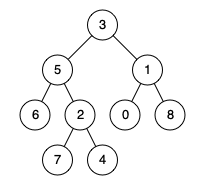题目描述:
Given a binary tree, find the lowest common ancestor (LCA) of two given nodes in the tree.
According to the definition of LCA on Wikipedia: “The lowest common ancestor is defined between two nodes p and q as the lowest node in T that has both p and q as descendants (where we allow a node to be a descendant of itself).”
Given the following binary tree: root = [3,5,1,6,2,0,8,null,null,7,4]

Example 1:
Input: root = [3,5,1,6,2,0,8,null,null,7,4], p = 5, q = 1 Output: 3 Explanation: The LCA of nodes5and1is3.
Example 2:
Input: root = [3,5,1,6,2,0,8,null,null,7,4], p = 5, q = 4 Output: 5 Explanation: The LCA of nodes5and4is5, since a node can be a descendant of itself according to the LCA definition.
Note:
他山之石:
1 # Definition for a binary tree node. 2 # class TreeNode(object): 3 # def __init__(self, x): 4 # self.val = x 5 # self.left = None 6 # self.right = None 7 8 class Solution(object): 9 def lowestCommonAncestor(self, root, p, q): 10 """ 11 :type root: TreeNode 12 :type p: TreeNode 13 :type q: TreeNode 14 :rtype: TreeNode 15 """ 16 # Stack for tree traversal 17 stack = [root] 18 # Dictionary for parent pointers 19 parent = {root: None} 20 # Iterate until we find both the nodes p and q 21 while p not in parent or q not in parent: 22 23 node = stack.pop() 24 25 # While traversing the tree, keep saving the parent pointers. 26 if node.left: 27 parent[node.left] = node 28 stack.append(node.left) 29 if node.right: 30 parent[node.right] = node 31 stack.append(node.right) 32 33 # Ancestors set() for node p. 34 ancestors = set() 35 36 # Process all ancestors for node p using parent pointers. 37 while p: 38 ancestors.add(p) 39 p = parent[p] 40 41 # The first ancestor of q which appears in 42 # p‘s ancestor set() is their lowest common ancestor. 43 while q not in ancestors: 44 q = parent[q] 45 return q
分析:
Python的pop()函数用于移除列表中的一个元素(默认最后一个元素),并返回该元素的值。
stack在代码中是一个动态数组,最初stack=[TreeNode(3)](以下直接以数字表示对应位置的树节点)。parent最初只是一个空的树节点。
第一个while循环相当于是对原二叉树的一个遍历,在遍历的过程中,parent树在不断生长,直到在parent树中检测到了节点p和q的存在,循环结束。
假如我们要寻找的两个节点是6和8,则parent树的生长过程如下:
最初stack=[3],用pop()方法将3弹出,检测它的左右子节点是否存在,若存在(此时左子节点为5,右子节点为1),则将左右子节点按照先左后右的顺序存入stack中。
在第一轮循环结束时,stack = [5, 1]。
parent树为:
3
/ \
5 1
接下来进入第二轮循环,将stack的最后一个元素(即1)pop出来,以同样的方法,检查它的左右子节点是否存在,若存在(此时左为0,右为8),则再次将左右子节点按照先左后右的顺序存入stack中。
在第二轮循环结束时,stack = [5, 0, 8]。
parent树为:
3
/ \
5 1
/ \
0 8
在第三轮循环结束时(在该轮循环中,只有pop,没有append),stack = [5, 0]。
parent树为:
3
/ \
5 1
/ \
0 8
在第四轮循环结束时(在该轮循环中,依然只有pop,没有append),stack = [5]。
parent树为:
3
/ \
5 1
/ \
0 8
在第五轮循环结束时,stack = [6, 2]。
parent树为:
3
/ \
5 1
/ \ / \
6 2 0 8
此时,在parent中恰好能够同时检测到6和8,循环结束。
程序中的第二个while循环
6-236. Lowest Common Ancestor of a Binary Tree
原文:https://www.cnblogs.com/tbgatgb/p/10924295.html